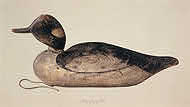
|
Duck Decoy Rendered by Max Fernekes (artist), 1937 watercolor and graphite on paper overall: 29.3 x 39.8 cm (11 9/16 x 15 11/16 in.) Original IAD Object: 12 3/4" long; 5 1/2" high Index of American Design 1943.8.17980 |
Object 23 of 26
The art of carving wooden birds, whether for use as decoys or for purely ornamental purposes, has long been popular in America. This example is from the Mason Factory in Detroit, which was active from 1896 to 1924. Large workshops produced decoys in response to the demands of commercial hunters before the industry came to a sudden end with the passage of the Migratory Bird Treaty Act in 1918. The Mason Factory was one of the most important suppliers of factory decoys, offering five different grades that varied in detail and degree of hand-finishing. This decoy was rated a Challenge grade (next to best). It was carved from a single block of wood except for the head, which was attached separately and featured glass eyes. The originally fine paint surface has worn considerably, but the bird is still recognizable as a bufflehead drake, even though it is slightly longer and less stocky than its living match. Decoy forms were typically kept low and broad to prevent them from overturning in rough water.
| « | back to gallery | » | continue tour |


